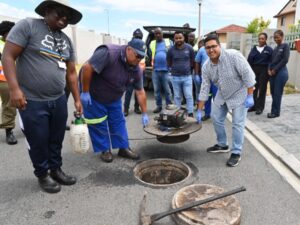For over a decade, the City of Cape Town’s Water Pollution Control Unit has been using smoke tests to combat pollution and sewage overflows as well as high volumes of excess water that can stretch the capacity of wastewater conveyance systems.
These overfalls typically occur in winter, when the increased rainfall puts added pressure on the city’s sewer system due to stormwater ingress. Some individuals or companies illegally connect their stormwater to the sewer system. This can potentially overload the wastewater treatment works and dilute incoming sewage, which paradoxically makes its treatment difficult owing to lower concentrations of organic matter in the water. The smoke-detection technology is used to trace pathways, making it easy to identify sections where water by-laws have been contravened. The process involves a machine known as a smoke blower, which is placed over a manhole leading into a sewer pipe. Once the machine is turned on and heats up, it pumps smoke through the pipeline. The smoke travels the path of least resistance and quickly shows up at sites that allow surface water inflow. Surveillance teams then note where the smoke leaks out and identify any broken manholes, illegal connections or weaknesses in the sewer infrastructure like cracked mains and laterals. Smoke detection also enables the city to identify gutter downpipes that direct rainwater into the sewer system, and detect connections where backwash incorrectly deposits straight into the stormwater system. Furthermore, it becomes easy to locate uncurbed sewer gullies, which are those without a barrier wall to stop stormwater from draining into the sewer system.If violations are discovered, the owners of the property receive a notice detailing the city’s findings and providing instructions for required repairs.
So far, the City of Cape Town has exceeded targets by testing 272 kms of sewer pipeline in the 2022/2023 financial year. The team is now well on the way to reaching its target of testing 170 kms in the current 2023/24 financial year. Areas are selected based on reports of:- Increased inflow into the nearest wastewater treatment works;
- increased sewer blockages;
- problems related to stormwater ingress; and
- sewer surcharges








